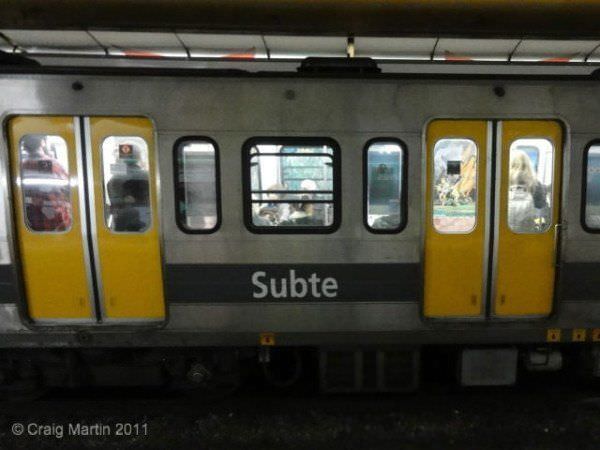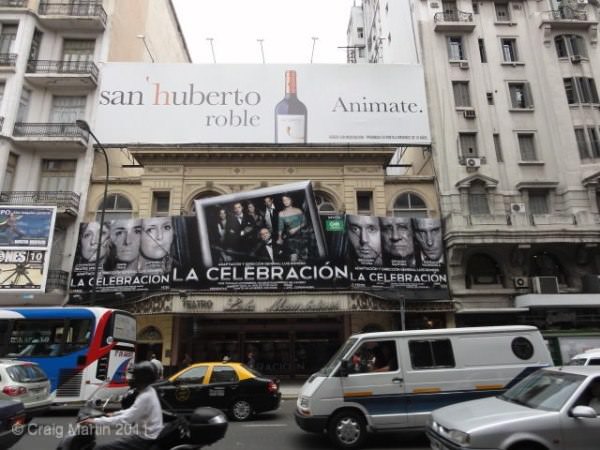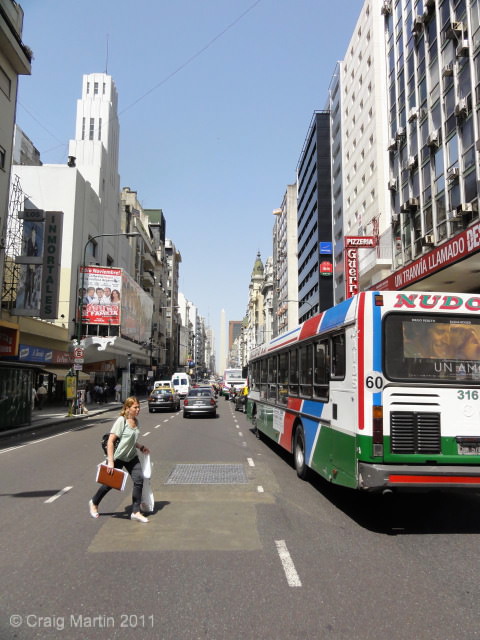The Buenos Aires transport system is generally very efficient, but can be a little confusing for first-time passengers.
Bus (colectivo)
There are dozens of private companies running competing colectivo lines, so there’s no hard and fast rules — but generally you pick the right bus, tell the driver where you are going, then drop some coins (generally ARS$2 or less) into the machine behind the driver. Take your ticket from the machine and find a seat.
Finding out any routing information is where things get tricky: there’s almost no information online. Your best resource is the “Guia T” — a paperback book available from most street kiosks and often sold on the subte. You can look up your destination and find the bus you’re after. Check your destination against the coloured placard on the bottom-right of the windscreen, and also with the driver. Bus 8 runs from the city to Ezeiza airport and back for ARS$2.
Buses run round the clock, but late night services are often spaced much further apart. Many colectivos are now part of the SUBE integrated ticketing system (see below).
Underground – the Subte
The Subte — Buenos Aires’s underground — is easily accessible, and runs from early until around 11pm most nights (shut-down begins around 10:30, although later on weekends).
The easiest way for short-term visitors to get around is to buy a 10-ride “subtepass” — there’s no cash saving, but it’ll certainly save you a lot of pain waiting in lines for individual tickets.

The Subte is now part of the SUBE integrated ticketing system (see below).
Train
The Buenos Aires train network connects Retiro, Constitución, Once and Federico Lacroze — the main stations — with suburban lines and the rest of the provence. They are not practical for short journeys within the central city, so tend to be ignored by most travellers passing through. There is a problem with petty theft in Buenos Aires train terminals, so take care, especially during the night.
Many train stations now support the SUBE integrated ticket system, explained below.
SUBE – Integrated ticketing for Buenos Aires public transport
In November 2011, the SUBE system was introduced, which allows an integrated ticketing system for buses, trains and the Subte in Buenos Aires.
On buses and the Subte, the system works on a tag-on basis; for trains, use a machine at the station to indicate your destination and type of journey (one way, return, etc) which will debit your card and activate it for the journey.
Note that each passenger needs their own SUBE card (you can’t use one card for two people or a group), and that you might still want to carry a some change around with you in case you run into a train station or collectivo that doesn’t accept SUBE yet.
More information, including where to buy and recharge SUBE cards is available at sube.gob.ar.
Taxi
Buenos Aires taxis have a black and yellow colour scheme, with a taxi lightbox on the roof. The red libre sign in the window indicates that a taxi is free. A radiotaxi is equiped with a radio for contacting their headquarters, and tend to be safer for tourists than other cars: we advise you to look for radiotaxis when hailing a cab.
All taxis in Buenos Aires have meters: make sure your driver turns his on.

Remis
A remis is similar to a taxi, but you prebook your journey, and prepay the fare at a local office known as a remiseria. This can help you avoid unscrupulous taxi drivers from driving you around in circles to increase the fare.
There are several remiseria at Ezeiza international airport: a journey into the microcentro will cost around ARS$130 and this makes for a safe and quick way to get into town (compared with ARS$2 for the public bus, which will take an hour longer).
On foot
 Buenos Aires is an excellent city to explore on foot: it’s then that you’ll find all the little niches, galleries, and small corners that give so much character to the place.
Buenos Aires is an excellent city to explore on foot: it’s then that you’ll find all the little niches, galleries, and small corners that give so much character to the place.
The day tends to be hot from midday to 5pm, so plan your wandering for the mornings and evenings, making use of public transport during the afternoon (or hide away for a siesta or lazy lunch instead!). Make sure you’ve got good sun protection and water during the hot season, and be prepared for heavy rain too… when the rain comes down, it really comes down.
The ‘museum mile’ from Recoleta to Palermo makes an good walk, with lots of galleries, museums and cafes (although cafes are cheaper on the side streets near museums). The parks of Palermo are an excellent place to find some green space — with lots of longboards and rollerbladers sharing the footpaths with you. Or, there’s the stretch from Plaza Dorego in San Telmo towards the microcentro. It’s not advised to walk far from the Caminito in La Boca or hang around near the train stations.
City bikes
You will see yellow city bike rental sheds around the city, but they are only able to be used by Buenos Aires residents. New residents to the Capital Federal can find out more information at http://mejorenbici.buenosaires.gob.ar
